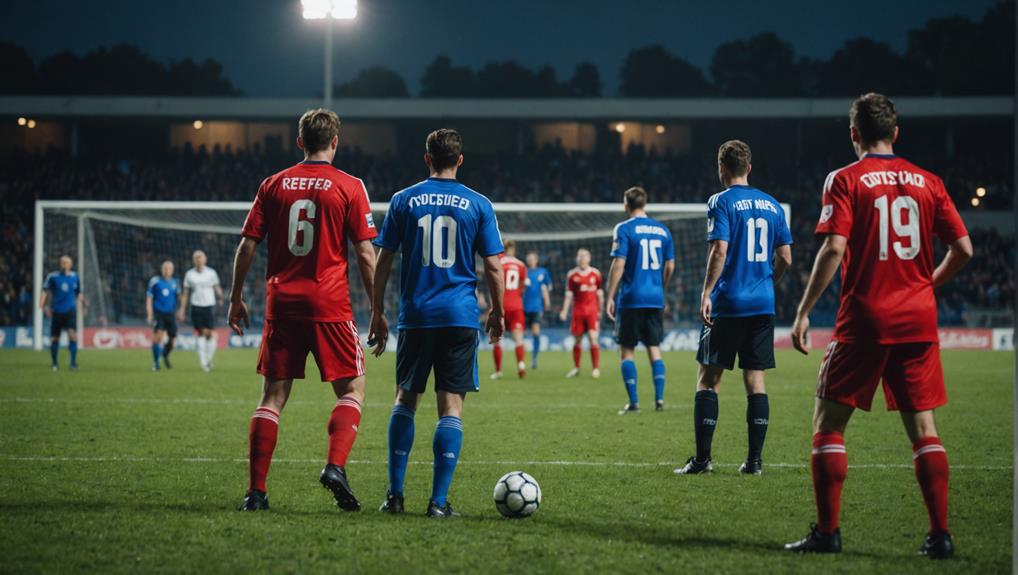
How Many Periods Are There in Soccer?
August 6, 2024In soccer, you have two periods called halves, each running for 45 minutes. During these halves, the game stops for a halftime break, and the referee may add time for delays. In high-stakes matches, there could be an extra 30-minute period. This setup allows for a balanced game flow and guarantees fairness. If you want to know more about how different leagues and age groups adapt their game lengths and periods, there are various factors like added time considerations, tie game resolutions, and the responsibilities of referees that influence the duration of soccer matches.
Professional Match Periods
In professional soccer matches, the game is divided into two halves, each lasting 45 minutes. These periods are essential as they determine the flow and intensity of the match. The halftime break provides players and coaches with a brief respite to regroup, rehydrate, and strategize for the second half.
During each half, the referee may add stoppage time to compensate for any delays that occurred during play. This guarantees fairness and allows for the full 45 minutes of play to be completed.
In high-stakes matches where a clear winner must be determined, extra time comes into play. This additional 30 minutes, split into two 15-minute periods, tests the endurance and skill of the players.
If the score remains tied after extra time, penalty kicks are used as a tie-breaker. This dramatic conclusion guarantees a definitive outcome, ensuring that one team emerges victorious. The pressure is intense during penalty shootouts, making them a thrilling yet nerve-wracking way to determine the winner of a closely contested match.
Youth League Variations
Professional soccer matches have structured periods, while youth league variations offer flexibility in game duration to cater to different age groups. Youth leagues adapt the number of periods and game length to meet the specific needs of players at various stages of development.
For instance, younger age groups like Under 6 may play four quarters of shorter duration to align with their attention spans and energy levels. As players progress to Under 10 leagues, they often engage in two longer halves to allow for more extended gameplay and skill progression.
Under 12 leagues commonly follow a format of two 30-minute halves without overtime, emphasizing skill development within a standard game length. These variations in period structures across youth soccer games aim to balance physical demands, skills development, and overall enjoyment, ensuring that players receive appropriate challenges and opportunities for growth based on their age group.
High School Match Periods

High school soccer matches typically include 2 periods of 40 minutes each. Some leagues may choose a different format, opting for 4 periods of 20 minutes each, but the standard remains the 2 halves.
The total game time for high school soccer games adds up to 80 minutes, which includes a 15-minute halftime break for players to rest and strategize. Period lengths in high school matches can vary based on league regulations and preferences, offering a dynamic playing experience.
This structure not only aligns with traditional soccer formats but also allows high school players to showcase their skills and compete effectively. The 2-period system in high school soccer provides a balanced game flow, ensuring players have ample time to demonstrate their abilities and contribute to their teams' success.
Youth Soccer Game Periods
Youth soccer games are structured into two periods, with the duration varying based on the age group. Under 6 leagues may have four quarters of 6 minutes each, while Middle school matches often feature two halves of 30 minutes each.
Game periods in youth soccer are tailored to promote player development and maintain competitive balance.
Youth Game Structure
When organizing youth soccer games, consider the appropriate number of periods based on the players' ages. The structure of periods in youth soccer games is vital for player development and securing age-appropriate play.
Here's what you need to know:
- Age Groups: Different age groups in youth soccer may play in quarters or halves.
- Quarters vs. Halves: Younger age groups often play in quarters, while older groups typically have halves.
- Example Formats: For instance, under 6 games may consist of 4 quarters lasting 6 minutes each, while under 14 games could involve two 35-minute halves.
- Player Development: The game format, including the number of periods, is designed to support player development and create a positive playing experience.
Understanding the youth game structure and period format in soccer is key to effectively planning and organizing matches. By aligning the periods with the players' ages, you can secure a more engaging and developmentally appropriate experience for young athletes.
Period Lengths
Consider adjusting the length of periods in youth soccer games based on the age group to secure an appropriate playing experience for the players. Youth soccer games for different age groups often have varying period lengths to match the developmental stage and attention span of the players.
For instance, younger children under 6 may play shorter games with two 10-minute halves or four quarters of 6 minutes each. As players progress to under 8, they might engage in two 20-minute halves or four 12-minute quarters.
Under 10 typically play two 25-minute halves, while under 12 advance to two 30-minute halves. This gradual increase in period lengths allows players to acclimate to longer gameplay gradually.
Adapting period lengths secures that young athletes can enjoy the game, develop their skills, and stay engaged throughout the match, promoting a positive soccer experience for all involved.
Additional Time Factors

How does the referee determine the amount of additional time to be added at the end of each half in soccer matches?
Referees add stoppage time to make up for delays such as injuries, substitutions, time-wasting, and interruptions during play. It's at the discretion of the referee to decide the amount of added time based on the time lost during the half.
In knockout matches, extra time may be added to establish a clear winner in case of a tie after regulation time. The main purpose of the added time is to ensure fair play by compensating for any time lost during the game.
Understanding these factors helps in appreciating the importance of added time in soccer matches. It guarantees that the game is played fairly and that any lost time due to interruptions is appropriately compensated for.
Tie Game Resolutions
To resolve tie games in soccer, various outcomes can be implemented, including a draw, penalty kicks, or overtime. In high-stakes matches like the FIFA World Cup, when the score remains tied after regulation time, extra time is introduced. This extra time consists of two periods of 15 minutes each.
If the tied score persists even after the extra time, the game enters the sudden death stage, where penalty kicks are used to determine the winner. The use of penalty kicks in tie game resolutions ensures a definitive outcome in pivotal matches.
The FIFA World Cup follows this format to guarantee a clear winner in matches that end in a draw after regular play. As a result, penalty kicks and overtime periods play an essential role in determining the victor in tied games, especially in prestigious tournaments like the FIFA World Cup.
Referee's Responsibilities

The referee in soccer holds significant responsibilities during a match, securing fair play and enforcing rules to maintain the game's integrity.
Here are some key responsibilities of the referee:
- Monitoring Game Time: The referee is in charge of keeping track of the time played and signaling when each half ends.
- Enforcing Fair Play: Referees secure that players abide by the rules and regulations of the game, promoting sportsmanship and fairness.
- Deciding Stoppage Time: In cases of delays due to injuries or other interruptions, the referee can add extra time, known as stoppage time, to compensate for these stoppages.
- Managing Penalty Kicks: During penalty kick situations, the referee oversees the process to guarantee fairness and adherence to the rules, playing a pivotal role in the outcome of these critical moments.
The referee's enforcement of regulations and quick decision-making are essential in maintaining the flow and integrity of the game.
Youth Soccer Game Lengths
As youth progress through different age groups in soccer, the game lengths vary to suit their developmental needs and abilities. In youth soccer games, under 6 matches typically consist of 4 quarters lasting 6 minutes each.
Moving up to under 10, both US Youth Soccer and AYSO leagues schedule games with two halves of 25 minutes each. Players in the under 12 category usually play two 30-minute halves following US Youth Soccer guidelines.
High school soccer games for freshman and JV teams involve 2 halves of 40 minutes each. Additionally, AYSO leagues organize under 8 games with 4 quarters lasting 12 minutes each.
Understanding these variations in game lengths is important for players, coaches, and parents to make sure that the duration of matches aligns with the age group's physical capabilities and learning objectives.
Conclusion
In soccer, the number of periods varies depending on the level of play. From professional matches with two halves, to youth leagues with shorter quarters, and high school games with regulation halves, the game length can differ.
Regardless of the number of periods, each game requires the referee to manage additional time factors and potential tie game resolutions.
So whether you're playing or watching, understanding the different periods in soccer adds to the excitement of the game.


